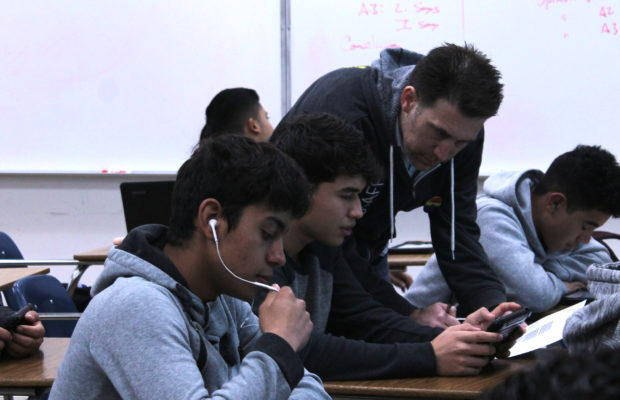Language barrier doesn’t stop ELL students

High school is never an easy experience, but for some students, the language barrier they face everyday makes the whole experience that much more difficult. According to the Conejo Valley Unified School District website, ten percent of the student population in CVUSD is made up of students who are learning English on various levels ranging from a new English speaker to a almost-fluent speaker. These students are emergent bilinguals, or English Language Learners (ELL), who face the same struggles as most high schoolers. However, they must deal with the added challenge of going to a school that predominantly speaks English.
Struggles in school
Learning English itself comes with its own slew of difficulties. “English is such a conglomerate of languages, and so it is really difficult to learn,” said Julie Tan, Spanish translator and bilingual facilitator for NPHS. “I am so proud of the kids that accomplish that, that are able to go through this program and move out of it having learned a level of proficiency where they can get it. They can understand, and that is the goal,” she said.
Santos Mejia, senior and ELL student, explained how he found school to be more challenging. “My classes, they speak fast,” Mejia said. “I’m not really good at English, not yet, so if [the teacher is] talking to me fast, I’ll tell him to talk slow to understand. That’s a difficult thing.”
Not only do ELL students have to face learning a new language, but many of them are also forced to handle gaps in their schooling. Carolina Rodriguez, California Lutheran University intern who works with the ELL students and former ELL student, explained that many students have an interrupted education. An interrupted education is for example “When you go only to fourth grade and then you don’t go [to school] for like two years,”Rodriguez said.
Tan provided information as to the background of some of the ELL students, “There are students here who have not been in school since third grade…a lot of them don’t have any math background, any English background [or any] science background.”
Principal Stephen Lepire explained that teachers work with all levels of students, sometimes within one class depending on their skill level. This is because many ELL students have varied backgrounds when they come to the school sometimes ranging from only a little schooling to a consistent education. “[Some ELL students] […] haven’t had school anywhere from one to five years, or have never been to school, and they’re 17 years old,” he said. This is what makes the program so crucial for students before they reach their senior year, in order to graduate.
Although the challenge of achieving proficiency in a new language is difficult to overcome, many students reach success. “When the students meet all the requirements to exit the ELD program, they have to take certain tests,” explained Tan. When they pass, they can be exited from the program as English proficient. “There’s just a smile on their face,” Tan said. “[It’s] one of my favorite moments… I don’t think the student body here at the school really appreciates how hard that is. So it’s really nice for me to be a part of that.”
Personal struggles
Taking general education courses while also learning a second language, ELL students have to contend with day-to-day challenges that are often second-nature to a native English speaker.
Christian Escobar, senior, is a former ELL student. He explained difficulties that come with both trying to speak and understand English simultaneously. “[The ELL class] helped me with vocabulary, how to pronounce some things, being more fluent,” Escobar said. “I think the hardest thing is how grammar works, and that’s the hardest part about learning.”
Despite how difficult it is to learn, students are motivated to learn and take advantage of the program facilitated by Tan. Tan recalls one of her favorite experiences when “a boy came to me and asked me how to ask the girl out on a date in English. And it was just, you know, a melt your heart moment.” It shows that the ELL students “want to learn English, they want to participate, just like all the other kids and it was just really sweet.”
Dealing with exclusion from the rest of their community, as well as being harassed for their differences, are two main struggles ELL students face. “People used to make fun of me when I didn’t say the word correctly. So I was very shy and I was afraid to speak up because then I felt like people were just like listening and then laughed,” said Rodriguez of her past.
“I want to say from personal experience that it’s hard for them probably to talk to other students that only speak English,” she said. “Because, yeah, we’re afraid we can’t communicate with you.”
Moreover, these students still have to face the problem that everyone does: growing up. “We’re talking about teenage years and a lot of things are changing hormonal changes and everything is happening,” Rodriguez said. ”So, [life] is very difficult.”
Through all of their struggles, ELL students are just like the rest of the school. They are not only capable of doing anything the English speaking students can, but they also bring different perspectives into the school. “Some people think that, ‘Oh you know they don’t listen,’ ‘They say bad words,’ they say all these things. But in working with the students, I really think they want to graduate,” said Rodriguez. Though ELL students face definitive struggles, they come out on top and succeed. “You see their small successes are really big,” said Tan.
School support
On top of the ELL teaching staff, students are offered a tutoring center at lunch during the week. “I really like the lunch student program because it really encouraged you to go. And my teachers always had an open door policy… So the help was there. And they went the extra mile to make us feel welcome,” said Rodriguez. Furthermore, Tan mentions “we also have a Latino Club, and they also are trying to help to bridge that gap and give people awareness of their culture and give the students a place where they feel like they welcome.”
The school has been trying to improve the situation for ELL students. “We’ve actually had some new classes this year…there’s technically three levels of ELD, one, two and three, we’re actually able to split them up into smaller class sizes. …we’ve actually been able to add a second paraprofessional to help support the students throughout the day, not only in their English class, but their other classes as well,” Lepire said.
Lepire further pointed out that the school effort is made up of many individuals. “Mr. Soto had [some ELL students] for math and provided them support in math class. Mrs. Rodriguez Martinez, one of our Spanish teachers, is running a Spanish class for those students…every situation is a little different in the sense of when [the ELL students] come to us. Mr. Ireta does a really good job of looking at their transcript and seeing what their previous education is.”
Despite the efforts within the school to help, there is a dire need for more volunteering. “We definitely need more volunteers, students who are willing to work with students. Like I said, I don’t even need to know Spanish to help them out. Just to read, and they love it,” said Rodriguez. Although the majority of students aren’t fully bilingual, the help of just reading to them is appreciated. “[The students] come to me, they’re like, ‘Oh my gosh, the reading is helping so much’ because she speaks such good English,” said Rodriguez. She also mentions that this volunteering can be used for Creativity Activity Service (CAS) hours.
“With the start of these tutoring programs, I think we are moving towards providing more support for students,” Rodriguez said. “[The students are] willing to put in the work. And I think that’s important.”
Please read the Spanish version of this article at the following link: https://pantherprowler.org/las-barreras-del-idoma-no-pueden-detener-a-los-estudiantes-de-ell/
Por favor, vea el siguiente enlace para leer la versión en español: https://pantherprowler.org/las-barreras-del-idoma-no-pueden-detener-a-los-estudiantes-de-ell/



